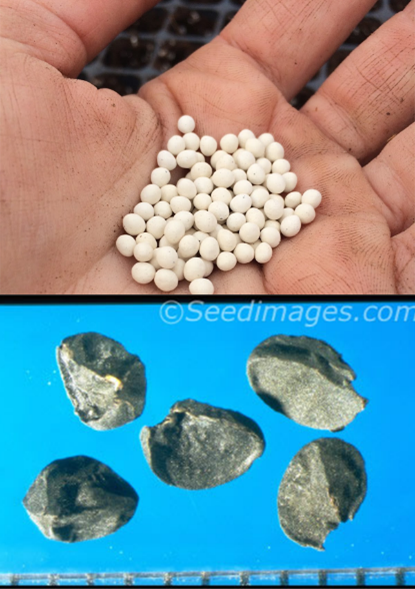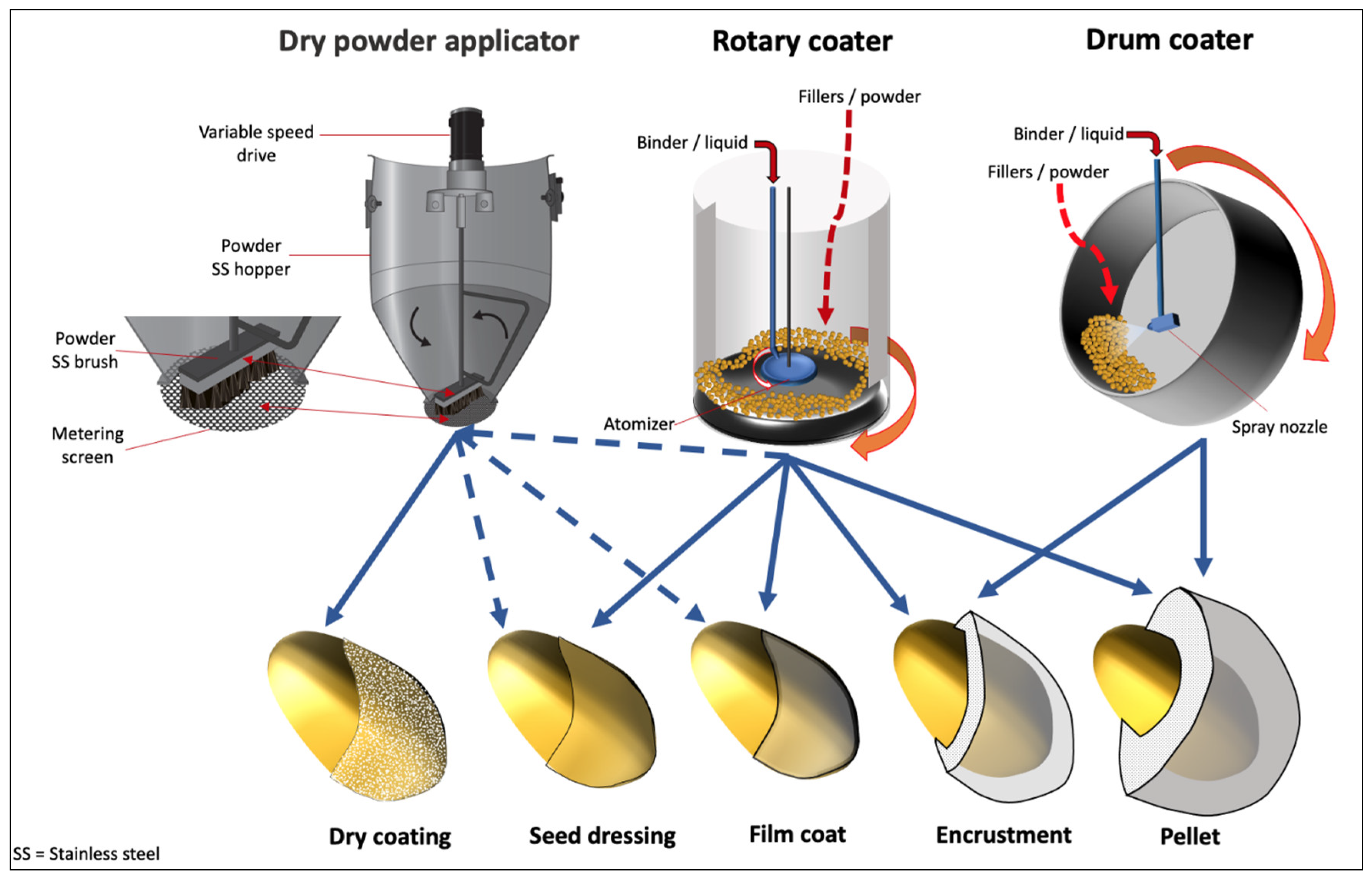7.7 – Seed Treatment Technologies: Seed Coatings and Seed Treatments
Many different materials are applied to seeds, including dyes, colorants, inoculants, fertilizers, seed coatings, and pesticides.
Seed Coatings
A seed coating is a material that changes the size, shape, or width of the original seed. Seeds can also be treated with pesticides during the coating process. However, coating and treatment are defined differently.
Seed coating covers seeds with external materials to improve handling, provide protection, and enhance germination and plant establishment.
The priming process regulates the seed’s temperature and moisture content, bringing it closer to the point of germination. This process enables seeds to reach a similar stage in germination, promoting faster and more uniform emergence when planted.
Some coatings and nutrients are approved for certified organic use.

Image: Uncoated onion seeds (bottom) vs. coated onion seeds (top). Source: Seedimages.com

Seed Treatments
Seed treatments are precise applications of chemicals or biological organisms intended to suppress, control, or repel target pests. Here, the term “pest” refers to insects and pathogens. Seed treatments protect seeds, seedlings, and plants from fungi, bacteria, insects that damage seeds or seedlings, and vectors of plant viruses and nematodes. Treated seeds are colored to ensure consumers can identify treated products.
Seed treatments and coatings are regulated by various laws, leading to some confusion. Treatments applied to a seed with a “control” claim are classified as pesticides. These materials are regulated by the Federal Insecticide, Fungicide, and Rodenticide Act (FIFRA). Pesticides used in seed treatments must be registered under FIFRA, and if applied by commercial applicators, the EPA requires those entities to be licensed. The EPA also mandates that treated seeds be colored for consumer knowledge and protection. However, once treated, the EPA and FIFRA step aside, and Federal and State Seed Laws then regulate seed treatment labeling.

Seed treatments provide preventive control as part of an integrated pest management system. They are typically used on high-quality seeds, such as certified or patented seeds with high germination rates, advanced genetic traits, and strong vigor.
Click on each item below to learn more about benefits and drawbacks.
Commonly Treated Crops in the Great Plains
- Oilseeds: Canola, soybean, safflower, sunflower
- Grains: Barley, corn, sorghum, wheat
- Fruits and Vegetables: Broccoli, cabbage, carrot, cauliflower, chickpea, cucumber, eggplant, lentil, lettuce, melons, pepper, spinach, squash, tomato, turnip
- Other Seeds: Alfalfa, clover, flower seeds, bean seeds, potato, sugar beet, turfgrass
Categorizing Chemicals Applied to Seeds
As mentioned, numerous products can be applied to seeds to prevent pests, adjust seed shape and color, improve flow, and enhance adherence. Pesticides used in seed treatments contain at least one active ingredient (a.i.) and additional “inert” ingredients such as adjuvants and additives that play important roles.
- Active Ingredients are responsible for preventing, repelling, or controlling the target pest. Primarily fungicides and insecticides are applied to seeds, either alone or in combinations, enhancing control if a pest is susceptible to multiple active ingredients.
- Adjuvants improve pesticide performance, while additives affect seed appearance or flow.
Seed treatments may protect the seed, seedling, or both. Contact treatments form a protective barrier around the seed, guarding the germinating seedling from insects and pathogens. Systemic seed treatments, which penetrate the seed, enter the plant’s vascular system, moving from roots to leaves and potentially remaining active during flowering, which could impact pollinators.
Examples of Common Seed Treatment Chemicals
Click on each to see examples of common seed treatment chemicals:
Labeling Treated Seed
For treated seed, two labels are required. Federal and State Seed Law mandates a regular seed label that indicates quality, germination percentage, purity, and test date. For treated seed, a second label is required to specify the treatment details:
- Indication that the seed has been treated
- The commonly accepted or chemical name of the treatment
- The statement “DO NOT USE FOR FOOD, FEED, OR OIL PURPOSES”
- Expiration date for inoculants, if present
READ ALL LABELS. If information is unclear, ask questions.
Storage and Disposal of Treated Seed
- Storage: Do not mix treated seed with food or feed products. Keep treated seed isolated and stored in a dry, well-ventilated area, separate from untreated seed. Dispose of contaminated bags properly.
- Disposal: Only produce the quantity of treated seed needed. Excess treated seed is handled as hazardous waste and must be disposed of according to state and local regulations.
- Excess treated seed cannot be composted, burned, or fed to animals.
- For small quantities, double planting may be an option.
- Larger quantities should be taken to approved landfills or disposed of via high-temperature incineration.
Review
Work through these interactive questions to review the important concepts discussed.

